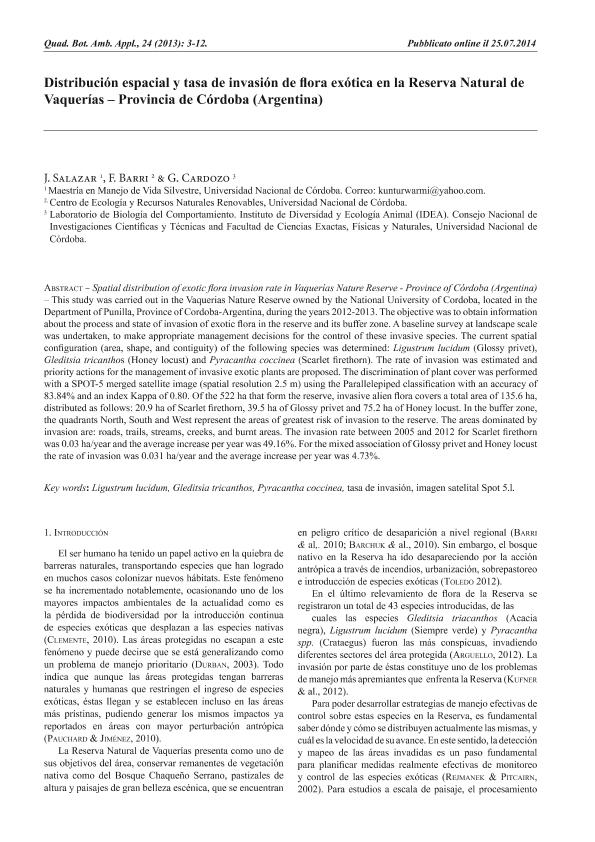Mostrar el registro sencillo del ítem
dc.contributor.author
Salazar, Julian
dc.contributor.author
Barri, Fernando Rafael

dc.contributor.author
Cardozo, G.
dc.date.available
2016-11-04T20:19:01Z
dc.date.issued
2013-12
dc.identifier.citation
Salazar, Julian; Barri, Fernando Rafael; Cardozo, G.; Distribución espacial y tasa de invasión de flora exótica en la Reserva Natural de Vaquerías, Provincia de Córdoba (Argentina); Universita di Palermo; Quaderni di Botanica ambientale e applicata; 24; 12-2013; 3-12
dc.identifier.issn
1121-3752
dc.identifier.uri
http://hdl.handle.net/11336/8000
dc.description.abstract
Nos propusimos usar como herramienta imágenes satelitales de alta resolución a fin de concretar los siguientes objetivos: 1. Determinar la configuración espacial actual (área, forma y contigüidad) de las coberturas de flora exótica invasora Siempre verde, Acacia negra y Crataegus. y 2. Estimar la tasa de invasión anual de las tres especies exóticas invasoras (período 2005-2012).
dc.description.abstract
This study was carried out in the Vaquerias Nature Reserve owned by the National University of Cordoba, located in the Department of Punilla, Province of Cordoba-Argentina, during the years 2012-2013. The objective was to obtain information about the process and state of invasion of exotic flora in the reserve and its buffer zone. A baseline survey at landscape scale was undertaken, to make appropriate management decisions for the control of these invasive species. The current spatial configuration (area, shape, and contiguity) of the following species was determined: Ligustrum lucidum (Glossy privet), Gleditsia tricanthos (Honey locust) and Pyracantha coccinea (Scarlet firethorn). The rate of invasion was estimated and priority actions for the management of invasive exotic plants are proposed. The discrimination of plant cover was performed with a SPOT-5 merged satellite image (spatial resolution 2.5 m) using the Parallelepiped classification with an accuracy of 83.84% and an index Kappa of 0.80. Of the 522 ha that form the reserve, invasive alien flora covers a total area of 135.6 ha, distributed as follows: 20.9 ha of Scarlet firethorn, 39.5 ha of Glossy privet and 75.2 ha of Honey locust. In the buffer zone, the quadrants North, South and West represent the areas of greatest risk of invasion to the reserve. The areas dominated by invasion are: roads, trails, streams, creeks, and burnt areas. The invasion rate between 2005 and 2012 for Scarlet firethorn was 0.03 ha/year and the average increase per year was 49.16%. For the mixed association of Glossy privet and Honey locust the rate of invasion was 0.031 ha/year and the average increase per year was 4.73%.
dc.format
application/pdf
dc.language.iso
spa
dc.publisher
Universita di Palermo
dc.rights
info:eu-repo/semantics/openAccess
dc.rights.uri
https://creativecommons.org/licenses/by-nc-sa/2.5/ar/
dc.subject
Ecología del Paisaje
dc.subject
Imágenes Satelitales
dc.subject.classification
Conservación de la Biodiversidad

dc.subject.classification
Ciencias Biológicas

dc.subject.classification
CIENCIAS NATURALES Y EXACTAS

dc.title
Distribución espacial y tasa de invasión de flora exótica en la Reserva Natural de Vaquerías, Provincia de Córdoba (Argentina)
dc.title
Spatial distribution of exotic flora invasion rate in Vaquerías Nature Reserve - Province of Córdoba (Argentina)
dc.type
info:eu-repo/semantics/article
dc.type
info:ar-repo/semantics/artículo
dc.type
info:eu-repo/semantics/publishedVersion
dc.date.updated
2016-11-02T18:13:01Z
dc.journal.number
24
dc.journal.pagination
3-12
dc.journal.pais
Italia

dc.journal.ciudad
Palermo
dc.description.fil
Fil: Salazar, Julian. Universidad Nacional de Córdoba; Argentina
dc.description.fil
Fil: Barri, Fernando Rafael. Universidad Nacional de Córdoba. Facultad de Ciencias Exactas, Físicas y Naturales. Centro de Ecología y Recursos Naturales Renovables; Argentina. Consejo Nacional de Investigaciones Cientificas y Tecnicas. Centro Cientifico Tecnologico Cordoba. Instituto de Diversidad y Ecologia Animal; Argentina
dc.description.fil
Fil: Cardozo, G.. Consejo Nacional de Investigaciones Cientificas y Tecnicas. Centro Cientifico Tecnologico Cordoba. Instituto de Diversidad y Ecologia Animal; Argentina
dc.journal.title
Quaderni di Botanica ambientale e applicata
dc.relation.alternativeid
info:eu-repo/semantics/altIdentifier/url/http://ortobotanico.unipa.it/quaderni/24_003.pdf
Archivos asociados
